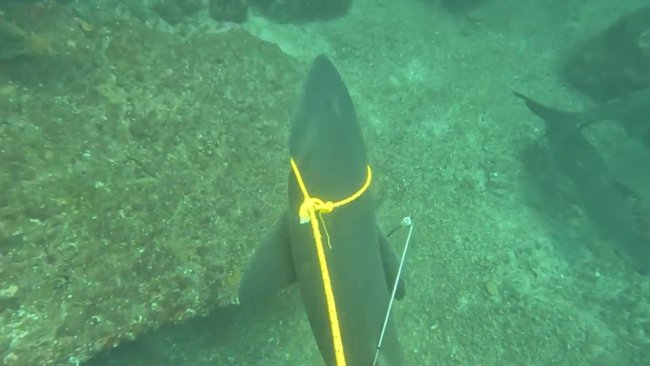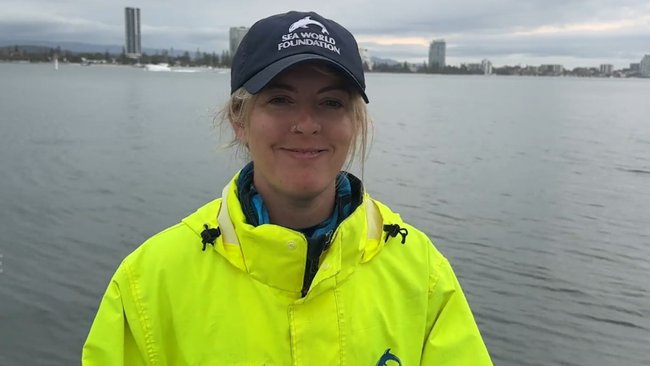Rescue workers have come to the aid of a critically endangered shark after it became tangled in a fishing line off the Queensland coast.
Sea World and Queensland Marine Parks sent out a rescue team to Flat Rock, a popular diving site off North Stradbroke Island, after local dive operator Manta Lodge and Scuba Centre spotted the distressed female grey nurse shark last week.
WATCH THE VIDEO ABOVE: Rescue teams save critically endangered shark caught in fishing line
Know the news with the 7NEWS app: Download today
Sea World Foundation Senior Aquarist Clint Karger said the call came in just before storms buffeted the state’s south-east, with a rescue called off until a weather window allowed the team to head out.
“Bad weather prevented us from getting out straight away,” he said.
“However, they were lucky enough to dive and see the shark again.”
Karger said the shark was eventually located at a spot on Flat Rock called Shark Alley.
Specialised dive and veterinary teams arrived at the site and managed to catch the shark on Friday afternoon and bring it to the surface to remove a hook.
 A grey nurse shark was spotted tangled in a finishing line after a hook became lodged under its jaw. Credit: Sea World
A grey nurse shark was spotted tangled in a finishing line after a hook became lodged under its jaw. Credit: Sea World
The dive team used a hoop and noose to lasso the shark before handing the rope over to the team on board the boat.
“We were lucky enough to find it,” Karger said. “They pulled the shark up alongside the boat, where it sits in a cradle (that is) still in the water, and it is still able to breathe,” he said.
Karger said they found a “very serious stainless steel hook” lodged in the shark’s mouth.
“I’m unsure what the fisherman were trying to catch with a rig that large, but it had actually hooked the shark underneath its jaw,” he said. “It’s really important that we’re able to help these sharks so they can live a normal life.”
Before returning the shark into the water, it was fitted with an acoustic tracker, allowing researchers to monitor her movements.
“It’s super rewarding,” Karger said
 Rescuers caught the shark using a specialised hoop and noose to lasso it. Credit: SEA WORLD
Rescuers caught the shark using a specialised hoop and noose to lasso it. Credit: SEA WORLD Senior Aquarist Siobhan Houlihan said it was the second grey nurse shark rescue the team has conducted this month. Credit: Sea World
Senior Aquarist Siobhan Houlihan said it was the second grey nurse shark rescue the team has conducted this month. Credit: Sea World
Sea World Foundation Senior Aquarist Siobhan Houlihan said this is the second grey nurse shark rescue the team has conducted this month, and is urging the community to fish more responsibly.
“While our team are pleased to be able to conduct these operations and give the sharks a second chance at survival, it is also disappointing as many of the injuries we are called to assist with are related to fishing apparatus entanglements,” she said.
Also known as sand tiger sharks, grey nurse sharks are a relatively placid and slow-moving shark with no confirmed human fatalities.
They range from about 2m up to 3m in length and can weigh up to 159kg. They undertake annual migrations up to 1000km to give birth in warmer waters.
The Queensland Government said the population is estimated to be no more than 2000 individuals, with a breeding population (males and females) thought to be about 400 sharks.
“Historically, commercial and recreational fishers targeted grey nurse sharks for their fins, liver oil and jaws,” the state government said.
“They are also frequently caught as bycatch in commercial fisheries, by recreational fishers and in shark control programs.
“Combined with their slow breeding rate, this puts their long-term survival at risk.”
Halloween shirt sparks global outrage: ‘Fire every single one of them’
2 min read
Optus boss resists calls to resign after triple-zero outage linked to deaths
2 min read

